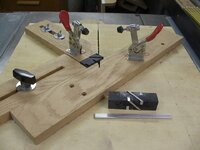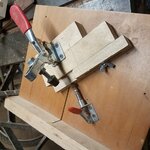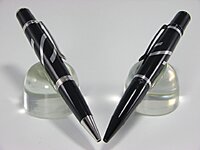ramaroodle
Member
I am trying to figure out what I'm doing wrong with the making of this blank. The knots are made of a strip of lacewood veneer sandwiched between 2 strips of figured maple veneer. (both commercial veneer from Rockler I had in the shop)
I've got 2 issues that I see right away. The bottom of my knots are obviously screwed up. Also, there appears to be "ghosting" around the edges of the knots but I'm thinking that it's because there is a gap between the insert and the blank which I should have clamped better. I notice that depending on the orientation the lacewood has striations that look like rope, which is interesting.
The bandsaw jig requires me to make 2 cuts in order for the slot to be wide enough to accept the veneer sandwich but it's hard to get the bottom of the cuts to line up perfectly.
1. Should I use a table saw jig instead of a band saw so the bottom of the slot is always square?
2. Should I not use veneer strips because they are too thin and are tearing out? It only seems to happen at the bottom of the cut which is why I think it might be related to the squareness of the slot.
3. I also notice that the edges of the knot layers are not as well defined as I would like. Could this also be due to the integrity of the veneer and I should find a way to cut my slices from solid wood vs commercial veneer?
Any advice would be greatly appreciated.

I've got 2 issues that I see right away. The bottom of my knots are obviously screwed up. Also, there appears to be "ghosting" around the edges of the knots but I'm thinking that it's because there is a gap between the insert and the blank which I should have clamped better. I notice that depending on the orientation the lacewood has striations that look like rope, which is interesting.
The bandsaw jig requires me to make 2 cuts in order for the slot to be wide enough to accept the veneer sandwich but it's hard to get the bottom of the cuts to line up perfectly.
1. Should I use a table saw jig instead of a band saw so the bottom of the slot is always square?
2. Should I not use veneer strips because they are too thin and are tearing out? It only seems to happen at the bottom of the cut which is why I think it might be related to the squareness of the slot.
3. I also notice that the edges of the knot layers are not as well defined as I would like. Could this also be due to the integrity of the veneer and I should find a way to cut my slices from solid wood vs commercial veneer?
Any advice would be greatly appreciated.



